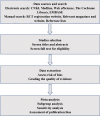Effect of robotic-assisted gait training on gait and motor function in spinal cord injury: a protocol of a systematic review with meta-analysis
- PMID: 37739462
- PMCID: PMC10533792
- DOI: 10.1136/bmjopen-2022-070675
Effect of robotic-assisted gait training on gait and motor function in spinal cord injury: a protocol of a systematic review with meta-analysis
Abstract
Introduction: Robotic-assisted gait training (RAGT) has been reported to be effective in rehabilitating patients with spinal cord injury (SCI). However, studies on RAGT showed different results due to a varied number of samples. Thus, summarising studies based on robotic-related factors is critical for the accurate estimation of the effects of RAGT on SCI. This work aims to search for strong evidence showing that using RAGT is effective in treating SCI and analyse the deficiencies of current studies.
Methods and analysis: The following publication databases were electronically searched in December 2022 without restrictions on publication year: MEDLINE, Cochrane Library, Web of Science, Embase, PubMed, the Cochrane Central Register of Controlled Trials and China National Knowledge Infrastructure. Various combinations of keywords, including 'motor disorders', 'robotics', 'robotic-assisted gait training', 'Spinal Cord Injuries', 'SCI' and 'gait analysis' were used as search terms. All articles on randomised controlled trials (excluding retrospective trials) using RAGT to treat SCI that were published in English and Chinese and met the inclusion criteria were included. Outcomes included motor function, and gait parameters included those assessed by using the instrumented gait assessment, the Berg Balance Scale, the 10-m walk speed test, the 6-min walk endurance test, the functional ambulation category scale, the Walking index of SCI and the American Spinal Injury Association assessment scale. Research selection, data extraction and quality assessment were conducted independently by two reviewers to ensure that all relevant studies were free from personal bias. In addition, the Cochrane risk-of-bias assessment tool was used to assess the risk of bias. Review Manager V.5.3 software was used to produce deviation risk maps and perform paired meta-analyses.
Ethics and dissemination: Ethics approval is not required for systematic reviews and network meta-analyses. The results will be submitted to a peer-reviewed journal or presented at a conference.
Prospero registration number: CRD42022319555.
Keywords: NEUROSURGERY; Neurological injury; REHABILITATION MEDICINE.
© Author(s) (or their employer(s)) 2023. Re-use permitted under CC BY. Published by BMJ.
Conflict of interest statement
Competing interests: None declared.
Figures
Similar articles
-
Comparative efficacy of robotic exoskeleton and conventional gait training in patients with spinal cord injury: a meta-analysis of randomized controlled trials.J Neuroeng Rehabil. 2025 May 29;22(1):121. doi: 10.1186/s12984-025-01649-1. J Neuroeng Rehabil. 2025. PMID: 40442684 Free PMC article.
-
The effects of robot assisted gait training on temporal-spatial characteristics of people with spinal cord injuries: A systematic review.J Spinal Cord Med. 2018 Sep;41(5):529-543. doi: 10.1080/10790268.2018.1426236. Epub 2018 Feb 5. J Spinal Cord Med. 2018. PMID: 29400988 Free PMC article.
-
Effects of robot-assisted gait training on cardiopulmonary function and lower extremity strength in individuals with spinal cord injury: A systematic review and meta-analysis.J Spinal Cord Med. 2024 Jan;47(1):6-14. doi: 10.1080/10790268.2023.2188392. Epub 2023 Mar 27. J Spinal Cord Med. 2024. PMID: 36972206 Free PMC article.
-
Walking speed is not the best outcome to evaluate the effect of robotic assisted gait training in people with motor incomplete Spinal Cord Injury: A Systematic Review with meta-analysis.J Spinal Cord Med. 2019 Mar;42(2):142-154. doi: 10.1080/10790268.2017.1390644. Epub 2017 Oct 25. J Spinal Cord Med. 2019. PMID: 29065788 Free PMC article.
-
Effects of Robot-Assisted Gait Training in Individuals with Spinal Cord Injury: A Meta-analysis.Biomed Res Int. 2020 Mar 21;2020:2102785. doi: 10.1155/2020/2102785. eCollection 2020. Biomed Res Int. 2020. PMID: 32280681 Free PMC article. Review.
Cited by
-
Prediction of gait recovery using machine learning algorithms in patients with spinal cord injury.Medicine (Baltimore). 2024 Jun 7;103(23):e38286. doi: 10.1097/MD.0000000000038286. Medicine (Baltimore). 2024. PMID: 38847729 Free PMC article.
References
-
- Zhang JM, Li N, Zhu L, et al. . Effects of pelvic floor biofeedback electrical stimulation combined with lower limb rehabilitation robot training on intestinal function of patients with spinal cord injury. J Brain Nerv Dis 2021;29:53–7.
-
- Xiang XN, Zhong HY, He HC. Research progress of lower limb exoskeleton rehabilitation robot in improving walking ability of patients with spinal cord injury. Chin J Rehabil Med 2020;35:119–22.
MeSH terms
LinkOut - more resources
Full Text Sources
Medical
Miscellaneous

